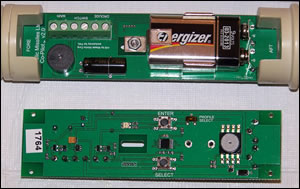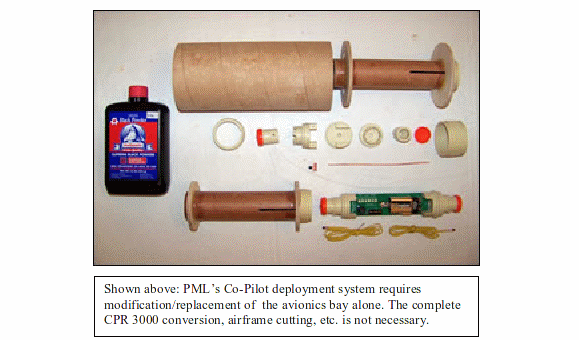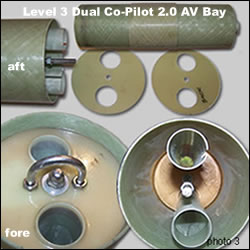| Manufacturer: | Public Missiles  |

Brief:
I have been flying the Co-Pilot 2.0 for about six months now with no failures. I've been flying high-powered rockets
for about the same length of time. Having also used several other brands of altimeters, some of which I have actually
flown and others I have actually returned. For simple deployment (single or dual), I doubt there is a better system
than this out there, and there's certainly not a company in our sport that offers better customer service, reliability
and delivers product faster or better than PML. If you are just getting into high power, don't make some of the first
mistakes I did, stick with PML until you simply must fly something else for some reason.

Construction:
When I first hit the Level 2 stage of my born again rocketry just a few months ago, the idea of altimeters was a bit
of a quandary--do I unscrew each unit from the oft-seen AV sled and re-screw it into the next rocket, put an altimeter
into every rocket to be flown that day, or what? Well, here's one answer: the Public Missiles Co-Pilot deployment
system.
I call it a system because no review of the PML Copilot 2.0 even scratches the surface without a discussion of the deployment portion (altimeter-housing section) of their CPR 3000/MAX system. I use them both for 2 simple reasons:
- Since it's a "2-sided" altimeter mounting on a G10 or plywood sled restricts access to the programming and ground testing features.
- Mounting another altimeter in the 38mm tube of the CPR systems becomes more complicated.
This is not to say you have to convert to the entire CPR system. It's simply designed to be best used with the PML altimeter mounting system and plugs right in to either phenolic or fiberglass components. They push their complete CPR-3000 system and I am sure it is wonderful, but I have a number of really nice conventional airframe/payload birds and didn't want to go hacking them up. So winging it, I have come up with this methodology using the parts listed here:

- 38mm Altimeter housing tube (slotted for the switch wire)
- Appropriate coupler tube for rocket
- Appropriate centering rings
- CPR-3000 Co-Pilot altimeter mounts
- Charge cylinder holders
- Charge cylinder canisters
- Canister caps (orange)
- O-rings (not shown)
- Safety switch
- Mounting strap with D-rings
I have not tried it in cardboard tubes. I like this system so much I own 2 Co-Pilots and am in the process of converting every suitable rocket I own. A custom fiberglass dual 38mm mounting system is being built into my current Level 3 fiberglass project.
It's a happy marriage. I have heard a comment or 2 that expanding ejection gas has a habit of leaking past the O-seals, etc., but I haven't seen it. I could see how it may happen if you weren't paying attention and forgot to use or used a damaged O-ring but that would fall under the heading of user error, not malfunction.
Let's look at what you get and what you don't get.
It's a 2-event (apogee, main) only system.
It's as plug-'n'-play/no brain as they come. You mount the battery to the altimeter (thus no requirement for holding one down separately), the altimeter to the PML mounts, thread the match(es), fill the ejection charge cylinders with 4F black powder, connect the switch and slide the entire unit into the tube. A screw cap holds it all in place. Turn it on and fly. Got another rocket to go? Unscrew the cap and repeat.
There's no stand-offs to lose, no tiny screws to play with and drop in the grass, everything rides on a 38mm sled and can be removed and reinstalled in under 5 minutes.
It's good for flights to 40,000ft MSL barometric and defaults for apogee deployment/main deployment at 1000ft AGL (above ground level) out of the box. A small switch is on the back (if you're old like me, you'll need your reading glasses) to toggle between a 1000ft and 500ft AGL main pop. You may never need to make any other adjustment for the life of the unit, there's no computer connection or other programming ever required.
It seems safe as they come. Like most altimeters, it beeps your pyro continuity (checks that your e-matches are connected) once fired up: one beep drogue, two for main, and three for both. The on board launch detection system does not arm the pyro channels until the rocket reaches 250ft, so if it doesn't get off the pad, it won't deploy.
It chirps the altitude like most units on the market, but unlike others it also flashes its LED at you as well, if (like me too) you have a hard time hearing high-frequency beeps with the roar of launching rockets in the background.
Of course if you want it to blow the main at 400ft, anticipate a mach-busting flight, or would like to ground test your flashbulbs, there are easily accessible buttons on the back labeled "Select" and "Enter" with bright LED indicator lights to input your choice of 16 operational mode preferences, set it up for redundant main or apogee deployment, drogue delays/main delays (0-3 seconds), up to 31 seconds of mach-delay (breaking the sound barrier is barometrically similar to apogee so this avoids deployment at like 800 feet-per-second), etc. To be straight up, competitive units that plug into your laptop are more fully programmable, however, one must ask the question, for 99% of your flights, is it worth sacrificing simplicity for?
It not only reports last altitude, but also last peak velocity, last time to apogee, and the number of your total, cumulative launches. The Diagnostics menu reports battery voltage, current MSL elevation, input testing (ground testing continuity on main and drogue), and there's an output test mode to test fire both pyros.
Summary:
Honest, they are not paying me to write this. I own and have owned several other altimeters (G-Wiz LCX, Ozark ARTS2,
and a Perfectflite MAWD) but this, coupled with the slide-in/slide-out AV bay is now my go-to 90% of the time because
it's easy and it works. I like it so much I bought another! If you need more programmability or pyro-channels, timer
capability, altitude, or something for staging and air starts, then keep shopping. If you want to have fun with a
single or dual-deployment, this is a no brainer approach. I betcha love 'em!
Other Reviews
- Public Missiles Co-Pilot 2.0 By Bob Morstadt (November 1, 2009)
I had the original PML Co-Pilot and flew it for several years until it went bad. I thought that I would simply replace the original Co-Pilot, but found that it had been superseded by the Co-Pilot version 2.0. One of the things that attracted me to the Co-Pilot version 2.0 is that the attachment holes on the electronics board are at the same location as the original. I ...
 |
 |